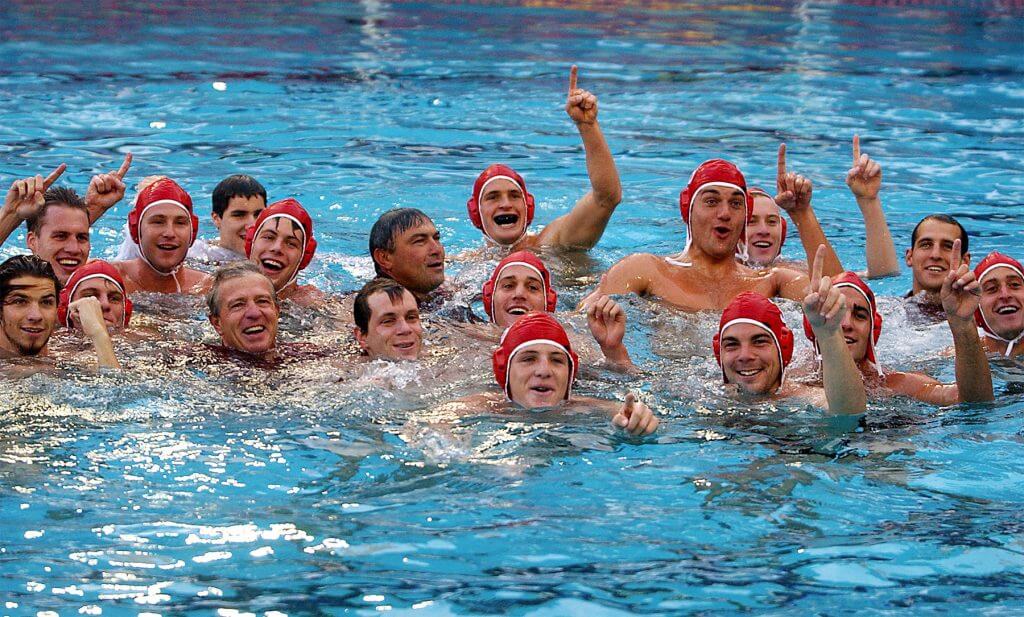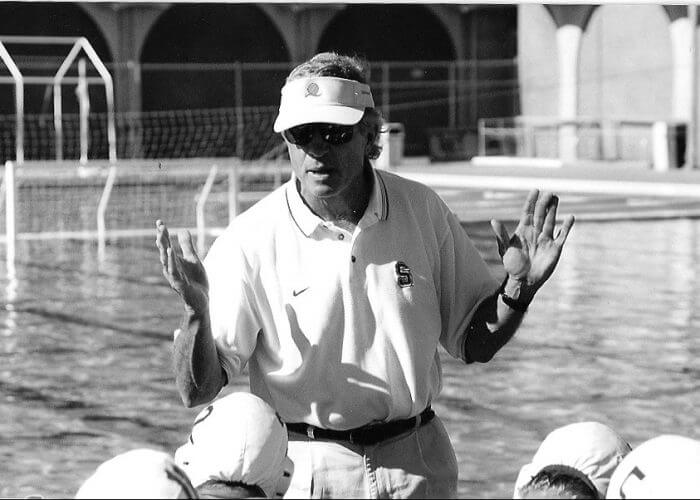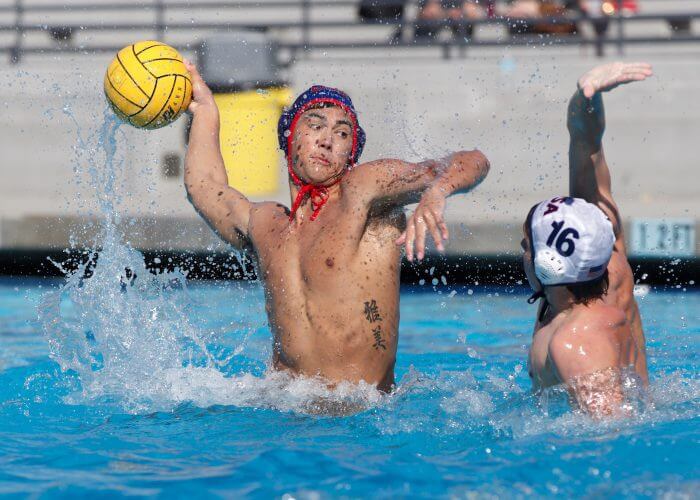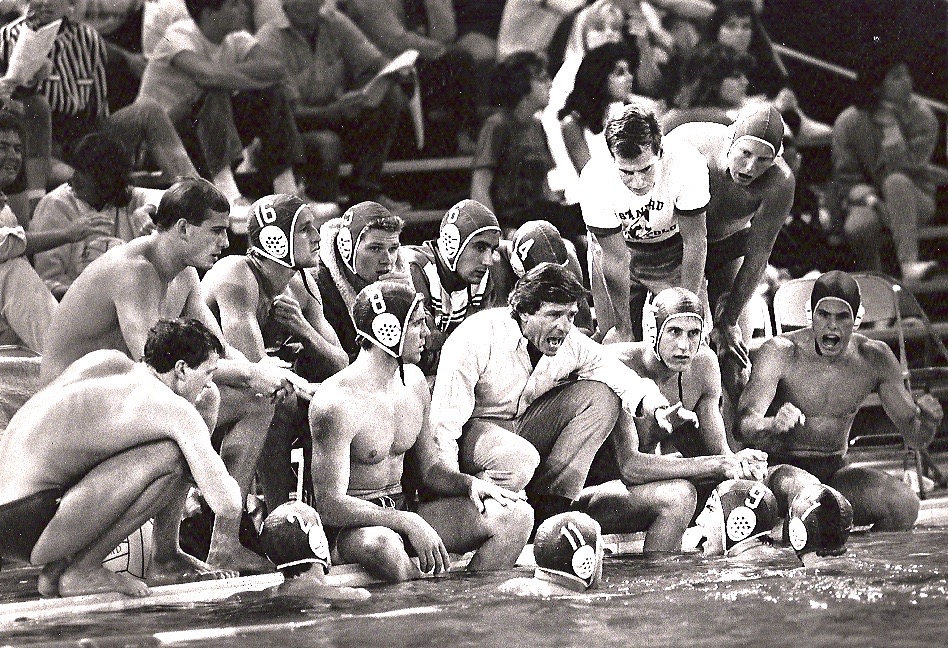Catching Up with Dante Dettamanti

By Michael Randazzo, Swimming World Contributor
Dante Dettamanti is a consistent—if sometimes lonely—voice for change within the international water polo establishment. One of the most successful coaches in the history of American intercollegiate polo, Dettamanti—or Coach D as he is affectionately known—believes that our national team should reflect the size and attributes of American players, and not look to emulate the Yugoslavian—now known as Serbian—school of water polo, which currently dominates the sport.

Dettamanti at Stanford. Photo Courtesy: D. Dettamanti.
Coach Dettamanti is no stranger to dominance; while coaching Stanford University’s men’s team from 1977 – 2001, he won a total of 570 matches. His Cardinal teams won 8 NCAA championships, and he remains the only coach in American intercollegiate athletics to have won championships in four different decades. His 666 wins from tenures at Occidental College (1971-73), UC Santa Barbara (1974-76) and Stanford make Dettamanti one of only two coaches in NCAA water polo history to top 600 wins.
Preaching a message that movement is essential to the future of water polo, Dettamanti points out that teams from Serbia, Croatia and Montenegro emphasize size and strength specifically because their players are larger than players from any other teams in the world. Advocating a change in focus for countries such as Greece, Italy, Spain and his native United States, he suggests these and other non-Balkan countries employ a movement offense that takes advantage of smaller, faster players to create offensive flow decidedly different from the center-dominated approach now in vogue.
Dettamanti spoke recently about the Team USA’s 15-7 loss to Japan in the 2017 FINA World Championships—the Americans’ first-ever loss to the Japanese—the status of the U.S. Men’s National Team, and what it will take to put American men’s polo back among the best programs in the world.
Is the loss to Japan one of the worst ever suffered by the US men’s water polo team?
It’s not the most humiliating loss ever, because Japan is a pretty darn good team. And the system they play gives a lot of teams trouble. The smallest team in terms of size of the players, they qualified for the Olympics [in Rio] for the first time in over 40 years by using a pressure defense, fast moving driving and counterattack on offense unique to their team.
The key to the Japanese system is that they play according to the players they have. It’s very similar to what I played for years at Stanford that emphasize driving and counterattack. We had a darn good counterattack when I was coaching at Stanford.
They do several things that is different than what other teams in the world do. First they start in a high press position. They almost invite you to drive. They force you to commit to a driving attack and then take advantage of your attack by countering you when you lose the ball.
Being in the press position throughout their opponent’s possession leads to a very effective counterattack. Most teams in the world do not do this. They usually play in a zone [defense]. It’s very difficult to counter from a zone, so you don’t see the counterattack like we used to have years ago when we pressed.
[American teams] used to press a lot, and we used to counter a lot. Back in the years when we had movement, and we had driving and we had counterattacks the United States was consistently top four or five in the world.
Now in the present system—which most teams use —the counterattack and driving are almost non-existent.
If you’re going to beat the Japanese you’re going to have to outscore them. They produce a lot of goals. With Japan countering up and down the pool, their opponent starts to get tired. Japan has made so many second half comebacks because they wear teams down. And the U.S. was just not able to keep up. We scored only seven goals in that game—we didn’t even reach 10.
You mentioned that the Japanese system suits their players. How does this compare and/or contrast with the current U.S. approach to their personnel?
For me, international water polo has become a big man’s game. You look at the rosters for the last three Olympics, and 99% of the players are over six feet tall. When I started coaching at Stanford [in 1977] half my team was 5-10 to 5-11. Look at the rosters today of the top four colleges; almost every player’s over six feet tall.
The problem is, people who are big in our country play football, they play basketball—they play other sports. We do have good athletes in water polo, but our best athletes are those that are 5-8 to 6-2. Like the Japanese, we have one thing going for them: we have excellent swimmers.
The Europeans don’t grow up swimming like the Americans do; [ours] is a swimming culture. We have to take advantage of that. We’re trying to play the European system, the Yugoslavian system which caters to the big players. The rules of the game now—as long as we have this rule [where] the ball goes into the center forward and [results in an] exclusion—this is what coaches are playing for. They don’t care about moving. And if you do move a lot of times the referees will call an offensive foul. That hurts the movement part of the game.
There are so many things that have added to the fact that we don’t move or drive any more. To cater to our players we have got to do that kind of a system. But the problem is we keep hiring Serbian or Croatian coaches here in the United States—[Dejan] Udovicic and [Ratko] Rudic—coaches who don’t play that system.
As long as we have Serbian or Croatian coaches, we’re not going to play that system. They are trying to fit the players into their system, rather than fit the system to the players we have in this country.
Given what’s happened at FINA Worlds should this be a wake-up call for Team USA coaches?
Possibly. The wake-up call should have been at the [Rio] Olympic Games. We did not make top eight. That’s the first time in history we’ve not made top eight. There’s your wake-up call right there.
Since Rio, Dejan might have thought more about using some smaller players, He did include some players this time who were a little smaller—[Johnny] Hooper, [Max] Irving.
Hooper is the poster boy for USA Water Polo’s Olympic Development Program (ODP); John Abdou specifically praised him when we spoke last month.

Johnny Hooper. Photo Courtesy: Catharyn Hayne
They’re claiming Hooper’s been in the system—but it had little to do with our ODP system. The kid was developed in high school and the clubs; it wasn’t ODP that developed him. They have changed their opinion about him in the past year. He was a great player when he was 15, 16 and 17 years old, probably the best in our country. But, in our system, they turned down Hooper to be on the national youth team because they said he was too small. He was denied the chance to be on our USA Youth and Junior team. Just think if he had been on our national youth team and our national junior team, and all the experience that he would have gained.
Here there’s the problem of universities. When a kid is in college, there’s nine months right there where it’s difficult for them to work out with the national team. They’re playing for their university’s team and they have academic requirements—they just can’t take time off. There are several university coaches who will not allow players to train with the national team—maybe for only a week or two before a world championship. Some of our college coaches are not allowing their players to train full time with the national team. Even in the summer they’re keeping their guys at home, and only allowing them guys to take off for one week of training and two weeks of playing overseas before a major tournament. But that’s not enough.
It’s tough on Dejan to deal with that. He’s trying to play his own system which doesn’t fit our players; and then he doesn’t have enough practice time… all these new players who are on the team this year. There’s three or four new guys; they’ve had very little practice time with the national team.
What positives can we take from a very challenging experience at FINA Worlds?
The only way that it’s going to change is if the coach changes his system, a system that he’s done his whole life, and he starts catering to American players. Or we get a new coach. We get an American coach who can play this sort of system.
The problem is, we have very few American coaches who can play this sort of system anymore, because they’re now copying the European system too. Much of the same system being played in Europe is played by our college coaches. We have a little more movement by driving or counterattacking at the college level. We actually have more movement on the women’s side than on the men’s side.
The question is: can we find a coach here in the US who is willing to make the necessary changes and play to the talents of the players that we have in this country?
But the leadership at USA Water Polo—not just the coach—has embraced this coaching philosophy. Can we expect them to dispense with all that even given this bad result?
The biggest problem is that the leadership of United States water polo does not know what’s going on—as far as understanding the game, as far as understanding what we need. John Abdou does, more than anybody else; but he doesn’t have the power to change anything.
If you look at our top administrators, they don’t know what’s going on. They see Dejan and that he was coach of a team that won championship after championship, and they won all these medals. But they overlooked the fact that he was let go by Serbia because he did not achieve the result they wanted, a gold medal. They overlooked the fact that we don’t have the same kind of players in this country that they have in Serbia.
What will it take to overcome the style that currently dominates men’s water polo?
As long as we have the current rules they’re going to continue to play this style. There’s kind of a revolution—if that’s what you want to call it—going on now in international water polo. There’s going to be some possible changes made in the game, there’s going to be some new people in the TWPC [FINA’s Technical Water Polo Committee], possibly a new president of FINA [Dr. Julio C. Maglione was re-elected]. They want to make some changes; because they are afraid that if we don’t play a more dynamic game that we could lose our position at the Olympic games. If that happens, water polo is done as an international sport.
We’re counting on FINA to support us. We’re caught in a situation where we should be on our own but do we need FINA to support us? If we go on our own will we lose that support from FINA?
I personally believe that the support from FINA is not that great! FINA cares more about swimming than it does about water polo. They just reduced two players on every water polo roster for the Olympic games to allow them to add three swimming events, because there’s a limit on the number of athletes at the Olympic games.
I would like to see us have our own international organization for water polo. All we have in common with swimming, synchro and diving is that we all use the water. That is like saying that track and field and basketball should be under the same umbrella because they are both played on land.
Is this a moment where people who care about water polo force the changes necessary to make the sport better?
I hope so. The problem is that most coaches and the people in water polo have been content going along with what we’ve been doing all these years. I’ve been warning that something like this was going to happen for the past three or four years. Nobody cared to listen—I was pretty much ignored.

Dettamanti speaking with his 1986 Stanford team, also an NCAA champion.
The straw that broke the camel’s back is when FINA decided to reduce the number of players on a water polo roster. That motivated all these international coaches who before this had been complacent—if you’re a coach from one of those countries, why would you want to make any changes? You’ve got to decide: are we playing this game for the good of the sport, or are we only concerned about winning medals?
Coaches from countries like Serbia, Croatia and Montenegro—they’re winning medals. In the past they could have cared less. They were fine with the system we’re playing right now. But going to 11 players showed that FINA doesn’t care about water polo, and it also showed that they are willing to sacrifice water polo for swimming.
Water polo should be a game that can be played by everybody. That is the only way that we can expand our sport around the world. The rules should be for everybody. We have very few countries in the world that play water polo. Part of that is because of pool space, economics, etc.—there’s a lot of problems with the sport. But when we don’t play a game that caters to people from other countries, we’re not going to draw more countries to play this sport.
It’s a bit like the situation with American baseball. The only players who get to the major leagues are those who have been groomed through the American system.
I’ve used the example of Rugby Sevens. They’ve changed the sport from big and slow Rugby Union to a more dynamic game; and it’s now the second most popular sport in the world after soccer. It is exciting, it’s fast… they added movement! This is what we’re missing in our sport. All the best sports in the world have movement—movement with and without the ball.
Other sports are attacking; in basketball you drive to the basket, in soccer you move with and without the ball. You see a 1-0 soccer game and everyone goes crazy because of the movement. It’s not the number of goals you score it’s the motion. You get these great 1-on-1 soccer players and they’re making their moves and going around defenders—you don’t see anything like that in water polo anymore.
Movement is the key to making water polo a better sport for people to watch. It’s hard enough to watch given that three quarters of the players’ bodies are underwater. Fans can’t see a lot of the action. But then we add insult to injury by stopping everybody instead of moving. People want to see movement. If we can get some motion into our sport it’s going to really help a lot.
The Junior Olympics—the largest youth polo tournament in the world—took place this month in Irvine, California. How does this and a relatively large pool of young athletes reflect where American polo will go?
How many of those kids realistically are going on to play for the national team? Any country can have a big tournament like that. You just invite a lot of teams. That’s basically what we have done. That doesn’t mean that it’s great water polo. If you look at the overall number of players in water polo in the United States, it’s actually rather low. If you look outside of California, it’s really low.
In this country water polo is competing with soccer, volleyball, football, basketball. And we’re getting kids playing. But in the overall picture, it’s still a very small sport in the United States. It’s a nice game, a fun game for young people to play but we’re not producing the top athletes that can fit into the national system.
We’ve had success in the past when the international system was more a movement system. Back then we didn’t have ODP. The high school and college system worked fine. And we won medals.
And it can still be done.
To read the interview with Dante Dettemanti in its entirety visit Water Polo Planet.




Great comments by Coach D!!! He is the man. Let’s bring the greatness back to the US water polo again. It’s boring without counter attack nor movement in water polo.
Hi: thanks for your comments. Not sure that—after watching Serbia and Croatia slug it out like two heavyweight prizefighters that I agree the Serbian school is “boring.”
However, I was impressed by the counterattacking style of the Japanese; let’s see what Coach Udovicic learned from that match and how he utilizes smaller, faster players like Johnny Hooper. Don’t forget, Udovicic was the architect of the team that is now referred to as Serbia’s “golden” team.
M. Randazzo
Coach Dettemanti certainly knows what he is talking about. His teams were always fit and fast and ready to use their speed for 4 solid quarters. Speed, counterattack, movement are all exciting for most sports/water polo fans to watch, but it seems USA Water Polo has chosen a different path.
Hi Steven:
Thanks for your comments. Coach Dettamanti is certainly VERY convincing in his analysis of the game and there is a very clear logic to the idea that a different approach – driving / counterattacking / movement could help restore the U.S. to prominence.
However, Coach Udovicic is signed through the 2020 Olympics and – with this move – USA Water Polo made a commitment to the style of play that Udovicic prefers. What’s interesting to me is how will he adapt to the reality of a younger lineup that may not fit his preferred style of play.
We shall see!
M. Randazzo
Very true. He was hired in May 2013 with very high expectations, much authority and significant budgetary leeway to mold USA Water Polo into international greatness. What are the parameters in which he is judged? Is it only or primarily the Olympic results in 2020?
Hi Steven: Thanks for your comments. I expect there will be a fair amount of soul-searching about the U.S. men’s performance at FINA Worlds. My plan is to interview Coach Udovicic when he’s available – probably in September – and get his take on all this.
There’s no doubt that the men needed a “culture transfer” from the old (Azevedo, Moses, Mann, Smith) to the young (Baron, Hallock, Obert, Dunstan, etc.) post Rio. I’ll mentioned Alan Abrahamson’s piece on the culture of success at the U.S. women’s program – http://www.3wiresports.com/2017/07/28/winning-culture-usa-womens-water-polo/. Can this continuity be created for the men? Not sure BUT if Coach Udovicic can affect this – and instill a basis for continued success – in my opinion he’ll have accomplished something significant (of course we can’t finish 8th or 10th in Tokyo, or – worse yet! – be beaten out by the Canadians for an Olympic berth).
Having said all this, I would add that what Tamas Marcz / the Hungarian men accomplished at FINA was nothing short of amazing, and might provide some lessons for the U.S. Marcz was hired in January – a VERY short timeline to prepare for a major tournament – and not only was his team competitive, they came within one bad period of capturing the biggest title in a non-Olympic year.
Can our coach inspire such a turnaround?
M. Randazzo
Hi Mike,
You can not compare the women team success with the men’s failure.
The US women team has no competition to speak of given the little interest in Eastern European countries which gives them a huge advantage over the competition.
Regarding the US men’s team they have to deal with professionals playing all year round in tough tournaments.
What I do find interesting is what coach D said about smaller players and speed. If you do not have the size you have to find other ways to win.
I think the loss to the Japanese was a fluke, the US team was not mentally prepare to be down with the Japanese and they broke down.
I think the reason water polo in the US is in trouble is because US water polo could not care less to develop the sport on the East Coast and the college rules do not allow to practice and compete all year round. On top of that a country of over 300mil people does not have a professional league.
I just came back from a town of 5000 people in Croatia which had 4 team and a tournament with attendance of about 1k people.
Until we do not have such enthusiasm for the sport in the US we will not be back in the first 5 teams in the world.
Mike: thanks for your comments, which I greatly appreciate. To break things down, I agree that you cannot include the U.S. men’s / women’s programs in the same conversation. When I spoke with John Abdou – https://www.swimmingworldmagazine.com/news/catching-up-with-usa-water-polos-john-abdou/ – he distinguished the differences between programs in a way that was crystal clear.
I can agree that the loss to Japan was a fluke BUT I think Coach Dettamanti was clear about the real warning sign – a poor performance at Rio. Our men’s team 13th place finish at FINA Worlds is perhaps just another data point in what has been a negative trend (trying to be impartial here).
As has been documented, the U.S., Canada, Japan and Australia are in the same boat when it comes to their men’s teams – again, I’m repeating here what I’ve been told. What I think will be interesting is how the U.S. takes this data and adjusts. I’m hopeful that in the coming months Coach Udovicic will speak with Swimming World to describe what those adjustments include – and perhaps that plan includes a competitive schedule against those nation’s teams rather than slugging it out with Serbia and Croatia (to name a few). Look at how the Hungarian women’s team looked to hone their ability against the U.S. – they’ve played multiple friendlies the past few years. Great idea but they couldn’t get past Canada when it counted, so I have mixed feelings about always focusing on the top teams.
Having now witnessed it first-hand, I also agree that the U.S. does not have the enthusiasm for polo that exists in Europe. BUT, we’ve both seen how popular polo is on the West Coast; IMO we need to focus on that positive – NOT at the expense of the East, of course – but figure out a way to promote the game at it’s highest level in this country.
As to the East, I’ll be deep into coverage of that region (where I live) and I hope there is progress. But the real challenge is can programs like Greenwich Aquatics produce players who can make varsity programs in the East; until that happens what we’re seeing is California kids who can’t break into the Big Four taking valuable spots on the rosters of CWPA members.
Lots to consider here; I look forward to your comments.
M. Randazzo